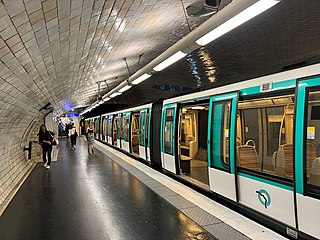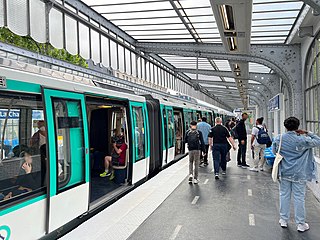
Châtelet is a station of the Paris Métro and Île-de-France's RER commuter rail service, located in the centre of medieval Paris, on the border between the 1st and 4th arrondissements. It serves RER A, RER B and RER D, as well as Line 1, Line 4, Line 7, Line 11 and Line 14 of the Paris Métro; it is the southern terminus of Line 11. The station is made up of two parts connected by a long corridor: Lines 7 and 11 under the Place du Châtelet and the Quai de Gesvre, next to the Seine; Lines 1, 4 and 14 towards Rue Saint-Denis and the Rue de Rivoli.

Les Halles is a station on Line 4 of the Paris Métro. Located in the 1st arrondissement, it takes its name from the market halls which were on the site for many years.

Gare d'Austerlitz, officially Paris-Austerlitz, is one of the seven large Paris rail termini. The station is located on the left bank of the Seine in the southeastern part of the city, in the 13th arrondissement. It is the start of the Paris–Bordeaux railway; the line to Toulouse is connected to this line. In 1997, the Ministry of Culture designated the Gare d'Austerlitz a historical monument; it became the fifth large railway station in Paris to receive such a label, as currently only Montparnasse has not been attributed it.

Porte Dauphine is the western terminus of Line 2 of the Paris Métro. It is situated in the 16th arrondissement. Avenue Foch station, served by the RER C line, is located nearby, as is Paris Dauphine University.

La Chapelle is a station on Paris Métro Line 2, on the border of the 10th and 18th arrondissements above the Boulevard de la Chapelle. The station is connected to the Gare du Nord and the Gare du Nord Métro station on lines 4 and 5.

The Gare du Nord, officially Paris-Nord, is one of the seven large mainline railway station termini in Paris, France. The station is served by trains that run between the capital and northern France via the Paris–Lille railway, as well as to international destinations in Belgium, Germany, the Netherlands and the United Kingdom. Located in the northern part of Paris near the Gare de l'Est in the 10th arrondissement, the Gare du Nord offers connections with several urban transport lines, including Paris Métro, RER and buses. It is the busiest railway station in Europe by total passenger numbers; in 2015, the Gare du Nord saw more than 700,000 passengers per day.

Balard is the southwestern terminus of line 8 of the Paris Métro in the 15th arrondissement of Paris. Since 16 December 2006, it has also been a stop on tramway T3a as part of the initial section of the line between Pont du Garigliano and Porte d'Ivry. The station is named after Place Balard, itself named after Antoine-Jérôme Balard (1802-1876), a French chemist and the discoverer of bromine. Among the stations serving the Boulevards des Maréchaux along the former gates of Paris, it is the only one not called Porte de…, though it serves the Porte de Sèvres.

Solférino is a station on line 12 of the Paris Métro in the 7th arrondissement. It is named after the nearby rue de Solférino, which in turn was named after the Battle of Solferino, a battle fought in 1859 during the Second Italian War of Independence, where the Franco-Piedmontese troops commanded by Napoleon III defeated the Austrians. It was also named after then passerelle Solférino, a footbridge over the Seine, now known as the Passerelle Léopold-Sédar-Senghor.

Magenta station is a station of the Île-de-France Réseau Express Régional (RER), in the 10th arrondissement of Paris, France. Built on the site of the Gare du Nord, the original name of Magenta station was Nord-Est with the possibility of a connection to both Paris-Nord and Paris-Est. In 2020 it was ranked the worst railway station in Europe by the Consumer Choice Centre.

Saint-Michel–Notre-Dame is a station on line B and line C of the Réseau Express Régional (RER) in Paris. Located in the 5th arrondissement, the station is named after the nearby Saint-Michel area and Notre-Dame Cathedral. The station opened, as Pont Saint-Michel and with platforms on the line that is now RER line C, in 1900. It gained its current name in 1988 with the opening of the line B platforms.

Musée d'Orsay is a station in line C of the Paris Region's Réseau express régional (RER) rapid transit system, named after the Musée d'Orsay, housed in the old Gare d'Orsay. It is in the 7th arrondissement of Paris. It was one of several stations attacked during the 1995 Paris Métro and RER bombings.

Nation station is a station of the Paris Métro and Île-de-France's RER commuter rail service. It serves Line 1, Line 2, Line 6 and Line 9 of the Paris Métro and RER A. It takes its name from its location at the Place de la Nation.

Charles de Gaulle–Étoile station is a station on Line 1, Line 2 and Line 6 of the Paris Métro, as well as on Île-de-France's commuter rail RER A. It lies on the border of the 8th, 16th and 17th arrondissements of Paris. Originally called simply Étoile, after its location at Place de l'Étoile, it took on the additional name of President Charles de Gaulle in 1970.

Châtelet–Les Halles station is a major train hub in Paris and one of the largest underground stations in the world. Opened in 1977, it is the central transit hub for the Paris metropolitan area, connecting three of five RER commuter-rail lines and five of sixteen Métro lines. The hub hosts 750,000 travellers per weekday and platforms separated by up to 800 metres (0.5 mi). It is named after the nearby Place du Châtelet public square and Les Halles, the former wholesale food market of Paris, now a shopping mall.

RER D is one of the five lines in the Réseau Express Régional, a hybrid commuter rail and rapid transit system serving Paris and its suburbs. The 190-kilometre (120 mi) line crosses the region from north to south, with all trains serving a group of stations in central Paris, before branching out towards the ends of the line.

RER E is one of the five lines in the Réseau Express Régional, a hybrid commuter rail and rapid transit system serving Paris and its suburbs. The 52.3-kilometre (32.5 mi) RER E line travels between Paris and eastern suburbs, with all trains serving the stations in central Paris, before branching out towards the ends of the line.

The Île-de-France tramways is a network of modern tram lines in the Île-de-France region of France. Thirteen lines are currently operational, with extensions and additional lines in both construction and planning stages. Although the system mainly runs in the suburban regions of Paris, lines T3a and T3b run entirely within Paris city limits, while lines T2 and T9 start their routes within Paris' borders. While lines operate independently of each other and are generally unconnected, some connections do exist: between lines T2 and T3a, T3a and T3b, T1 and T5, T1 and T8, T8 and T11 Express, T3a and T9 and T6 and T10. However, the final design of the entire planned tram network is fairly integrated.

Porte de Clichy is a station on Line 13 and Line 14 of the Paris Métro and RER C, as well as a stop on Île-de-France tramway Line 3b. Located in the 17th arrondissement, the Métro station is situated on the northwestern branch of Line 13, under the Avenue de Clichy. It serves the Tribunal de grande instance de Paris. The station is named after the Porte de Clichy, a gate in the nineteenth century Thiers wall of Paris, which led to Clichy.

Rosa Parks station is a railway station in the 19th arrondissement of Paris, France near the Porte d'Aubervilliers. It is on the RER network, and also has a tram stop. The station opened on 13 December 2015, and bears the name of American civil rights activist Rosa Parks.

Bagneux station is a station on the line B of the Réseau Express Régional, a hybrid suburban commuter and rapid transit line. The station takes its name from its location near the city of Bagneux, Hauts-de-Seine, but the station itself is inside the town of Cachan.






















